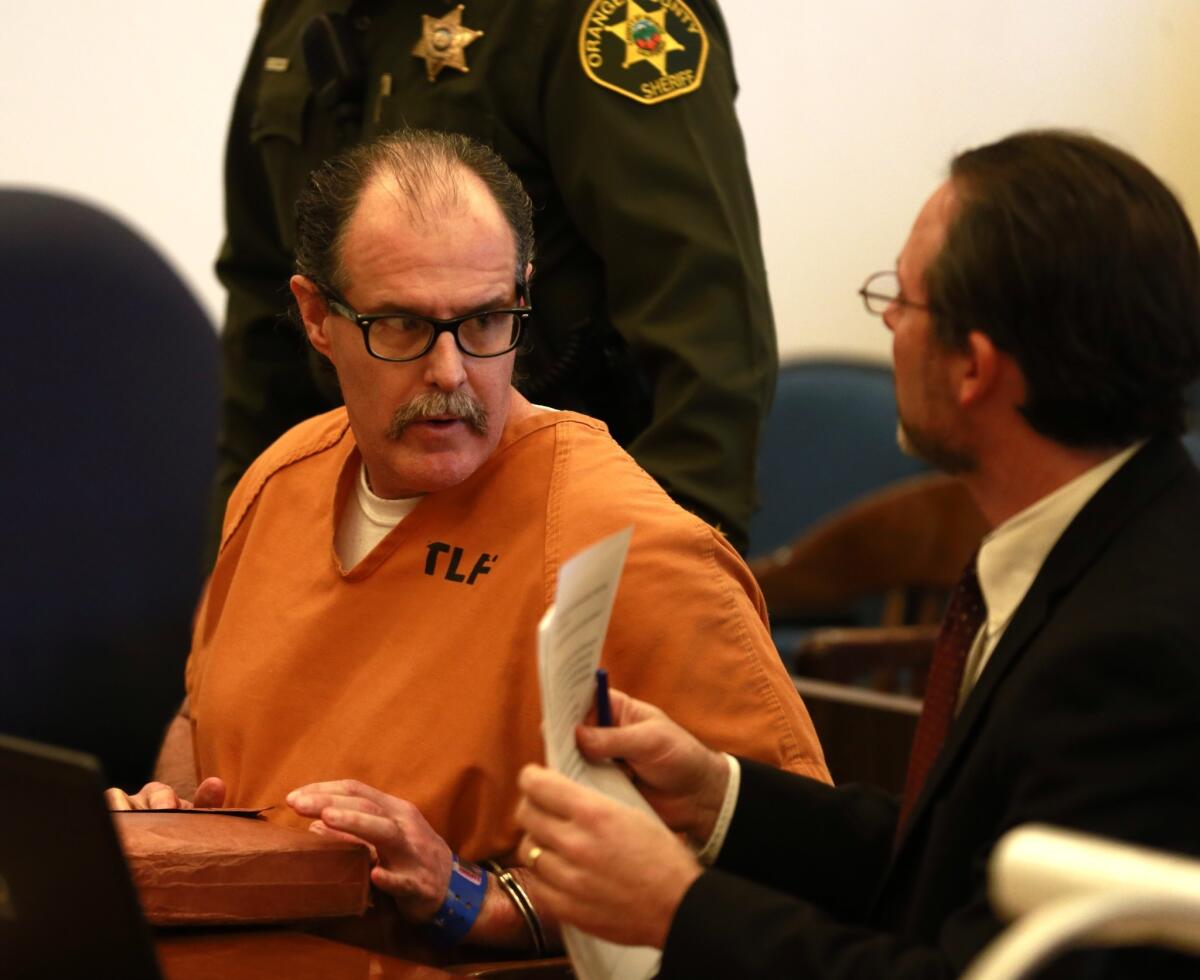Judge boots D.A. from Seal Beach mass killer case; death penalty remains

An Orange County Superior Court judge has removed the district attorney’s office from handling the case against a man who killed eight people at a Seal Beach hair salon in 2011 but said the assailant will still face the death penalty.
The ruling follows accusations that the government mishandled the case against Scott Dekraai, who last year pleaded guilty to gunning down his ex-wife and seven others in Orange County’s deadliest shooting.
Superior Court Judge Thomas Goethals was sharply critical of the district attorney’s handling of the case, saying the killer’s due-process rights had been violated by the prosecution’s “chronic failure” to turn over evidence.
Goethals described prosecutors conduct as “a comedy of errors but for the fact that it has been so sadly deficient.”
Reacting to the ruling, Paul Wilson, the husband of one of the shooting victims, said: “I’m embarrassed and disgusted. I hope that [Dist Atty.] Tony Rauckauckas and his office are held accountable for this. Today I blame them.”
------------
FOR THE RECORD, 3:40 p.m.: An earlier version of this post misspelled the last name of Dist. Atty. Tony Rackauckas.
------------
Christy Wilson, the mother of three, was among those killed inside Seal Beach salon.
“Tony Rauckauckas is like the captain of the Costa Concordia. He jumped ship before it sank,” Wilson said.
On Oct. 12, 2011, Dekraai -- wearing a bulletproof vest and armed with three semiautomatic handguns -- opened fire in a Seal Beach hair salon where his ex-wife worked. He shot as he walked from station to station at the tiny salon, then shot the driver of a parked car as he left.
Dekraai pleaded guilty in May to eight counts of first-degree murder. Since then, Assistant Public Defender Scott Sanders had argued that his client should be spared the death penalty.
Sanders said Orange County jailers had routinely flouted defendants’ rights with an illegal jailhouse-informant operation, and that prosecutors had repeatedly covered it up.
The dispute centered on a man known as Inmate F, who had the knack of being nearby when defendants incriminated themselves. After his shooting rampage, Scott Dekraai found himself in a jail cell next to Inmate F.
Exactly what 42-year-old Dekraai told him about his crimes, amid 132 hours of surreptitious jailhouse recordings, has never been made public -- and the district attorney’s office agreed to toss out the secret recordings.
Sanders argued that the recordings — and the fact that a host of law-enforcement witnesses somehow neglected to mention them during hours of questioning last year — highlighted what he had said all along: Jailers orchestrated Dekraai’s movements from the start and then refused to come clean about it.
How did Dekraai end up next to the informer? Coincidence, the district attorney’s office maintained. “Mere happenstance.”
For two years, Sanders tried to prove that was a lie.
Judge Goethals in August refused to remove the D.A.’s office or dismiss the death as an option for Dekraai. Instead, he ruled — after months of contentious hearings — that the mistakes were “negligent rather than malicious.”
As the second round of informant-related hearings drew to a close, new evidence was before the judge: a trove of documents revealing the existence of secret jail logs that showed jailers’ notes about Dekraai.
Since Dekraai pleaded guilty, he faced one of two fates: life in prison, or death row. In its zeal to win a death sentence against Dekraai in an expected jury trial, Sanders wrote in a recent motion, “The government spent years hiding and lying about evidence that undermined their version of events.”
Sanders contended that his effort to unravel the informant program had cost him years of work he could have spent building Dekraai’s defense, and that Orange County prosecutors couldn’t be trusted to play fair.
The district attorney’s office acknowledged that the secret jail logs were turned over to the defense “tardily” but said it didn’t affect Dekraai’s ability to get a fair trial, particularly since Dekraai’s recorded jailhouse remarks would never be heard by jurors.
“We don’t feel that what has happened over at the jail has any bearing on his ability to receive a fair penalty phase,” prosecutor Howard Gundy said.
The district attorney’s office said that jail personnel, including a nurse, moved Dekraai into a convenient and visible cell in a ward for medical observation, and that it was only coincidentally next to Inmate F, the “prolific and inveterate informer” whose real name is Fernando Perez.
“No one involved in placing defendant and Perez in adjacent cells had any inkling that Perez had been a government informant,” prosecutors wrote in court papers.
At last year’s hearing, jailers in the sheriff’s Special Handling Unit — which works with informants — distanced themselves from the decision to put Dekraai in that cell. “In a medical ward like that we pretty much don’t have any say,” said Sheriff’s Deputy Ben Garcia.
At one recent hearing, Sanders sought to undermine that claim with a note from Dekraai’s secret jail log, written when the surreptitious recordings were underway. In it, a jailer wrote that Dekraai was “not to be moved regardless of medical or mental health request.” This showed jailers were in control all along, Sanders said.
During earlier hearings, another jailer, Seth Tunstall, downplayed his role in dealing with informants. Sanders confronted him with an affidavit Tunstall had written, in another case, in which he listed one of his duties as “developing confidential informants.”
“I guess I put the wrong word in there,” said Tunstall, a veteran jailer with a doctorate in psychology who brought his own lawyer to court to advise him. “I did not mean ‘develop.’”
In reality, Tunstall said, he had “supervised the passing of information” from jailhouse informants to other agencies.
Follow @LATChrisGoffard on Twitter.
